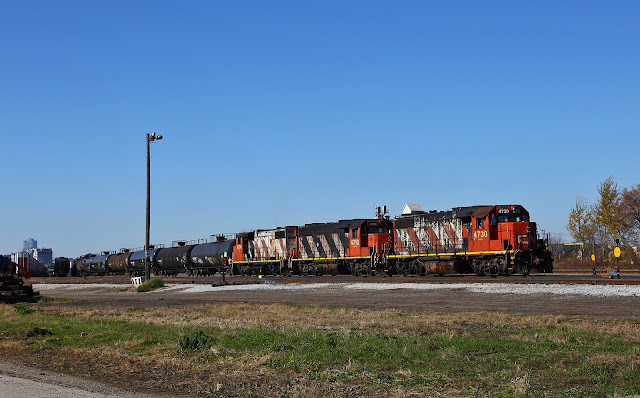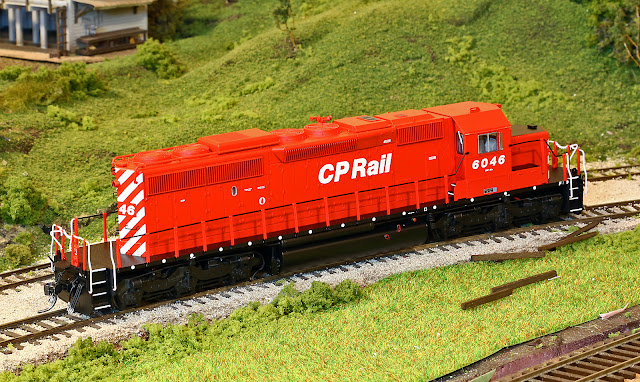Okay, time to get back to something actually model railroading-related. I hope to have more HO-themed articles in the next few weeks and less 1:1 scale posts, not that there's anything wrong with real-world railroading, but the intent for this blog was to be primarily about 1:87 scale railroading. Progress on the layout and various HO locomotive projects has been slow, but I have a lot of things "nearing completion" I hope to feature in the near future.
 |
| Walthers' recent Mainline-series release, the so-called 59' Clindrical Grain Car, produced in droves in prototype by Marine Industries. |
Anyway, with the relatively-recent release of Walther's so-called 59' grain hopper, I was keenly interested to get my hands on one and see what the model would be like. No doubt this would car would have a tough act to follow in that Intermountain has cranked out models of the same prototype for years. Walthers' Mainline series is their budget-minded line of less-detailed but more affordable products (such as it is today with prices subject to fluctuations in both the US and Canadian dollars), so admittedly, expectations weren't that high to begin with. This is not intended to be a A-Z review, but rather a narrative describing things Walthers got right and things they got wrong.
The first thing I noticed about the car was the price - retail is $29.98 US, which works out to about $40 CAD, plus tax. For a budget car, that's a bit steep, especially when the far better-detailed Intermountain version of the same car can still be found without much difficulty at train shows for $30 or less (same paint schemes, too). The car comes well-packed in a somewhat-larger-than-necessary box with a plastic two-piece shell holding the car in place. One thing that was known when the model was announced was that it would come with plastic "end cage" (roofwalk supports and grab irons) detail, and plastic roofwalk. While this does solve the common problem of etched-metal roofwalk warp, the trade-off is a noticeably-thicker profile. Admittedly, if you view the car at a 90-degree angle, it's not too bad, definitely better than the old Athearn blue-box details, but as soon as one sees the car at an angle, it's easy to see just how thick the "engineering plastic" is - pretty thick. On the B-end, the brake dear is present and reasonably-well done, but the plumbing connecting the brake components again suffers from chunky-plastic syndrome. That trait further extends to the grab irons and stirrup steps. One thing done fairly well (among others) is that the top hatches are relatively well-detailed, and apparently more reliable than the Intermountain version (I can't seem to keep those hatches in their hinges). Another thing done fairly well are the brackets supporting the roofwalk along the length of the car. The car comes equipped with Walthers free-running 100-ton trucks and Kadee-like metal couplers. Early tests indicate that the Walthers version of the car doesn't suffer from the common problem the Intermountain cars faced wherein the the inboard wheelsets on each truck contact the brake piping detail underneath the car, sometimes leading to derailments.
 |
| A side view of the car reveals a noticeable gap between the side sill and the hopper sheets, most prominent at the middle of the car. |
A couple flaws, at least on this particular sample, serve to detract from the car's overall appearance. The first and more obvious, there is a noticeable gap in the seam between the car's side sill and the hopper sheets. It appears that Walthers chose to cast these as separate pieces, and the fit-up between the two leaves a bit to be desired (and would likely be difficult to correct). The second issue is with the graphics; while generally well-executed, a few spots had fuzzy or even blurry contrast between the two colours, most notable between the yellow and brown, but also between brown and black at the BL-corner of the car. A further, more subtle detail, is that the prototype car has 9 weld seams between the hopper sheets, while the model has 12; again, this is not a rivet-counter's car, but is something that could have been accounted for at the factory prior to production.
 |
| Note the fuzzy colour separation, particularly at lower right between yellow/black, yellow/brown, and at the stirrup step, between black and brown. |
 |
| A top-down view of the roofwalks illustrates the size and coarse nature of the roowalk grid pattern. |
In short:
Pro's:
- It closely matches prototype dimensions (well, it is a scale model...)
- Tracks well
- Some elements are well-executed such as top hatches and roofwalk supports
- Lettering is generally sharp
Cons:
- Sloppy fit-up results in gap between side sill and hopper sheets
- No way to hide how thick the plastic components are, such as roofwalk, end cage details
- Sloppy paint application in several places
- Wrong number of hopper sheet weld seams
- For what it is, relatively high price
This isn't meant to be a knock against Walthers - in truth, they have done some incredibly well-executed models such as the 52' bulkhead flatcar. In this case though, I'm not sure what they were aiming for, offering a middle-of-the-road model that has already been done in much better quality, for nearly the same price (there is a price difference between a new Intermountain version and the Walthers', but not what I'd expect given the detail differences). Aside from being a rerun, the execution of the model leaves a fair bit to be desired in several areas, so it appears that Walthers was intent on offering "something" to the budget-minded modelling crowd, but may have only been interested so long as profit margins allowed. While the poor fit-up and paint may be exclusive to this single sample (doubt it), the fact is that other areas such as the roofwalk are hard to overlook. As food-for-thought, Scale Trains recently, with their Operator line, offered an entirely new model (never before made in HO) with better execution and at a substantially lower price; thus it is possible to do a budget car well.
Verdict: I'm sticking to my Intermountain version.
Hope this review helps some potential buyers,
'Til next time,
Cheers,
Peter.






























